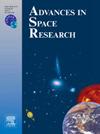太阳风与人为月球外大气层相互作用的混合等离子体模拟
IF 2.8
3区 地球科学
Q2 ASTRONOMY & ASTROPHYSICS
引用次数: 0
摘要
本文章由计算机程序翻译,如有差异,请以英文原文为准。
Hybrid plasma simulations of the solar wind interaction with an anthropogenic lunar exosphere
In the coming decades, exploration of the lunar surface is likely to increase as multiple nations execute ambitious lunar exploration programs. Among several environmental effects of such activities, increasing traffic near and on the lunar surface will result in the injection of anthropogenic neutral gases into the lunar exosphere. The subsequent ionization of such anthropogenic neutrals in the lunar environment may contribute to and ultimately exceed the generation of ‘native’ lunar pickup ions, thereby altering the fundamental space plasma interaction with the Moon. To better understand these possible effects, we conducted plasma simulations of the solar wind interaction with the Moon in the presence of increasing ion production rates from an anthropogenic lunar exosphere. At ionization levels between 0.1 and 10 times the native lunar exospheric ion production rate, little to no changes to the solar wind interaction to the Moon are present; however, ionization levels of 100 and 1000 times the native rate result in significant mass loading of the solar wind and disruption of the present-day structure of the Moon’s plasma environment. Comparing to the planned Artemis landings, which are likely to contribute only an additional 10% of the native lunar exospheric ion production rate, we conclude that the Artemis program will have little effect on the Moon’s plasma environment. However, more frequent landings and/or continual outgassing from human settlements on the Moon in the more distant future are likely to fundamentally alter the lunar plasma environment.
求助全文
通过发布文献求助,成功后即可免费获取论文全文。
去求助
来源期刊

Advances in Space Research
地学天文-地球科学综合
CiteScore
5.20
自引率
11.50%
发文量
800
审稿时长
5.8 months
期刊介绍:
The COSPAR publication Advances in Space Research (ASR) is an open journal covering all areas of space research including: space studies of the Earth''s surface, meteorology, climate, the Earth-Moon system, planets and small bodies of the solar system, upper atmospheres, ionospheres and magnetospheres of the Earth and planets including reference atmospheres, space plasmas in the solar system, astrophysics from space, materials sciences in space, fundamental physics in space, space debris, space weather, Earth observations of space phenomena, etc.
NB: Please note that manuscripts related to life sciences as related to space are no more accepted for submission to Advances in Space Research. Such manuscripts should now be submitted to the new COSPAR Journal Life Sciences in Space Research (LSSR).
All submissions are reviewed by two scientists in the field. COSPAR is an interdisciplinary scientific organization concerned with the progress of space research on an international scale. Operating under the rules of ICSU, COSPAR ignores political considerations and considers all questions solely from the scientific viewpoint.
 求助内容:
求助内容: 应助结果提醒方式:
应助结果提醒方式:


